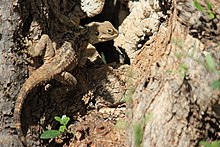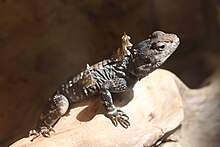Hardun
| Hardun | ||||||||||||
|---|---|---|---|---|---|---|---|---|---|---|---|---|

Hardun ( Stellagama stellio ) |
||||||||||||
| Systematics | ||||||||||||
|
||||||||||||
| Scientific name of the genus | ||||||||||||
| Stellagama | ||||||||||||
| Baig , Wagner , Ananjeva & Böhme , 2012 | ||||||||||||
| Scientific name of the species | ||||||||||||
| Stellagama stellio | ||||||||||||
| ( Linnaeus , 1758) |

The Hardun ( Stellagama stellio , Syn .: Agama stellio , Laudakia stellio ), also known as the sling tail, is a lizard from the agam family . It is widespread from Greece and Cyprus through Turkey to the Middle East .
features
The males of the Harduns are up to 38 centimeters long, the females 30 to 35 centimeters. These agamas are remarkably robust and have equally strong limbs with long claws. Their upper side is covered with strongly keeled (thorny) scales, especially near the eardrums , in the area of the jaws, as well as on the tail and legs. The males also have a row of thickened scales in front of the cloaca and a double longitudinal row of them above the abdomen. The whorl-like spiny tail makes up about two thirds of the total body length. The back color appears light to dark gray, brown or - with strong tanning - even almost black. The drawing is irregular; there are often pale yellowish, almost rhombic spots on the back and pale speckles all over the trunk. The undersides of the abdomen and limbs are yellowish; the throat is mottled dark. The drawing of the tail is determined by an alternation of dark and light rings. In the mating season, the males are quite conspicuously reddish or orange in color.
distribution
The hardun is common in the Middle East and parts of Southeast Europe. Specifically, northern Saudi Arabia , Iraq , SW Syria , southern Lebanon , Israel , Jordan , the Sinai Peninsula and northern Egypt , Turkish Anatolia , Cyprus and Greece with central Macedonia and some of its islands in the Aegean belong to the distribution area . This makes the Hardun the only agamen species native to Europe . The populations in northern Greece, on Corfu , Malta and around the Egyptian Alexandria are based on the introduction of humans.
Way of life and reproduction
The hardun, in need of warmth, prefers rocky regions with strong sunlight and corresponding buildings, ruins and stone walls. It also occurs on tree trunks in light groves. The animals are often noticeable by nodding their heads on their raised seats. Even air and soil temperatures of 60 ° C are tolerated - other reptiles usually seek out shady spots in the midday heat. The species is very shy towards humans. Specimens react defensively if they are caught and caught despite a violent flight by scratching and biting hard. Natural enemies include large species of adder and domestic cats.
The preferred food of the Hardune consists of crickets , beetles and grasshoppers , but smaller lizards and juveniles also fall victim to the sling tail . Plant parts are also occasionally part of the diet.
Hardunes mostly live in groups with a dominant male, a few lower-ranking males, several females and adolescent young animals. The females are usually mated by the highest-ranking male and later each lay eight to ten eggs.
Subspecies
- Stellagama stellio brachydactyla (Haas, 1951); Jordan, Saudi Arabia, northern Sinai and southern Israel.
- Stellagama stellio cypriaca (Daan, 1967); Cyprus
- Stellagama stellio daani (Beutler & Frör, 1980); Macedonia, Central Cyclades , Salonika , Aegean Islands and the coast of Turkey.
- Stellagama stellio picea (Parker, 1935); Black lava deserts in Jordan, Syria and Saudi Arabia.
- Stellagama stellio salehi Werner, 2006; southern Sinai and the extreme south of Israel.
- Stellagama stellio stellio (Linnaeus, 1758); Greece, various Cycladic islands, Turkey, Syria, Lebanon, central and northern Israel and western Jordan.
- Stellagama stellio vulgaris (Sonnini & Latreille, 1802); northeastern Egypt around Alexandria and Cairo, possibly also the Sinai coast.
Hazards and protective measures
This species is widespread and is also found in various protected areas. In Israel it is generally protected. The IUCN therefore classifies the Hardun as potentially endangered ( Least Concern ). In Egypt there are threats from unregulated wild-caught animals for the zoo trade and from habitat loss when the coastal zones are expanded.
literature
- Günter Diesener, Josef Reichholf : amphibians and reptiles (= Steinbach's natural guide. ). Mosaik-Verlag, Munich 1986, ISBN 3-570-01273-5 .
- Khalid Javed Baig , Philipp Wagner , Natalia B. Ananjeva, Wolfgang Böhme : A morphology-based taxonomic revision of Laudakia Gray, 1845 (Squamata: Agamidae). In: Vertebrate Zoology. Vol. 62, No. 2, 2012, ISSN 1864-5755 , pp. 213-260, ( digitized PDF; 3.88 MB ).
Web links
Individual evidence
- ↑ Stellagama stellio in the IUCN Red List of Threatened Species 2013.2. Posted by: Amr, ZSS, Al Johany, AMH, Akarsu, F., Üzüm, N., Kumlutaş, Y., Baha El Din, S., Lymberakis, P., Hraoui-Bloquet, S., Ugurtas, IH, Werner, YL, Disi, AM, Tok, V., Sevinç, M., Sadek, R., Crochet, P.-A., Kaska, Y., Avci, A. & Yeniyurt, C., 2012. Retrieved on May 29, 2014.

